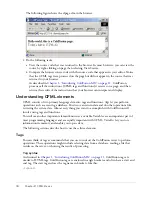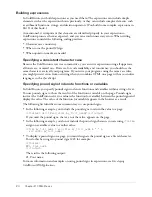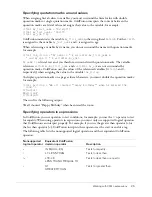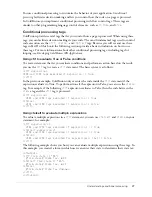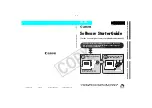
12
Chapter 1: Introducing ColdFusion MX
What is ColdFusion MX?
ColdFusion MX is a powerful web application server that lets you create robust sites and
applications without a long learning curve. ColdFusion MX does not require coding in traditional
programming languages (for example, C/C++, Java, XML), although it supports these traditional
programming languages.
ColdFusion MX consists of the following core components:
•
ColdFusion server
•
ColdFusion Markup Language (CFML)
•
ColdFusion Administrator
The following sections describe these core components in more detail.
The ColdFusion application server
The ColdFusion application server is itself a web application that typically resides on the same
computer as your web server software. It is the program that parses (reads and interprets) and
processes supplied instructions. These instructions are passed to ColdFusion through ColdFusion
pages, which use a CFM or CFC file extension. A ColdFusion page looks like an HTML page but
contains special tags that instruct the ColdFusion server to perform specific operations.
How ColdFusion processes pages
The following steps explain how the ColdFusion server processes a ColdFusion page:
1
The ColdFusion server looks at the content of the page and searches for the following
ColdFusion instructions:
■
Tags that begin with
cf
.
■
Variables and functions that are always surrounded by pound signs (
#
).
2
If the ColdFusion server finds any HTML or plain text in the page, the ColdFusion server
returns it to the web server untouched.
3
The ColdFusion server processes all the ColdFusion instructions found, and returns any
remaining results to the web server. The web server then sends the entire output to the browser.
The ColdFusion Markup Language
ColdFusion Markup Language
(
CFML) is a a tag-based language similar to HTML that uses
special tags and functions. With CFML you can enhance your standard HTML files with
database commands, conditional operators, and high-level formatting functions, and rapidly
produce easy-to-maintain web applications.
CFML looks similar to HTML: it includes start and end tags, and each tag is enclosed in angle
brackets. All ending tags are preceded with a forward slash (/) and all tag names are preceded with
cf
; for example:
<cfstarttagname> </cfendtagname>
Building applications with CFML
You build ColdFusion applications as a series of pages that use CFML. Developers can extend
this language by creating their own custom tags or user-defined functions (UDF), or by
integrating COM, C++, and Java components (such as JSP tag libraries).
Summary of Contents for COLDFUSION MX 61-GETTING STARTED BUILDING COLDFUSION...
Page 1: ...Getting Started Building ColdFusion MX Applications...
Page 6: ...6 Contents...
Page 10: ......
Page 30: ...30 Chapter 2 CFML Basics...
Page 36: ...36 Chapter 3 Database Fundamentals...
Page 48: ......
Page 76: ...76 Chapter 6 Lesson 2 Writing Your First ColdFusion Application...
Page 134: ...134 Index...


















